Greetings everyone out there in Radio-land, and welcome to our show, Everything You Always Wanted to Know About Air-To-Water Heat Pumps* (*but were afraid to ask). Our hosts John Barba, Director, Sales Training NA, Taco, and Dave Holdorf, Product & Application Instructor – East, Taco, both of whom have a face for radio, are here Read more
air to water heat pump
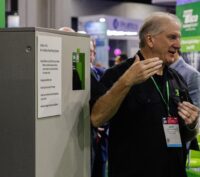
Greetings everyone out there in Radio-land, and welcome to our show, Everything You Always Wanted to Know About Air-To-Water Heat Pumps* (*but were afraid to ask).
Our hosts John Barba, Director, Sales Training NA, Taco, and Dave Holdorf, Product & Application Instructor – East, Taco, both of whom have a face for radio, are here to take your questions and, if a miracle occurs, provide you with coherent answers.
And now, here are your hosts, direct via satellite from Cranston, Rhode Island – John and Dave!
John: Thank you everybody, and welcome to our show. I’m John and on the other microphone is Dave. Say hello, Dave.
Dave: Hello Dave.
John: Yep, those 11 semesters at the Connecticut School of Broadcasting are really paying off, aren’t they? Let’s get right to your calls and tackle some questions on Air to Water Heat Pumps. Dave, who’s our first caller?
Dave: First up JB, we have Elliot from Kansas City. Elliot, you’re up. What’s your question?
Caller: Hi, this is Elliot from Kansas City. Am I on?
John: Hi Elliot, you’re live, coast to coast. There are literally tens of people waiting on your question.
Caller: Wow. Tens, huh?
Dave: Okay, maybe dozens. So . . . what’s cookin’ Elliot?
Caller: Well, it’s pretty basic, but – how many BTU’s? What size house can I do with an air to water heat pump?
John: That’s a great question, Elliot. We get more calls about that than anything else. First, understand that any air-based heat pump extracts heat from the air using a refrigeration cycle. And it stands to reason that the colder it gets outside, the less heat there is in the air to, you know, extract.
Dave: That’s correct, JB. So as it gets colder out, the actual output of an air-to-air or an air-to-water heat pump goes down. So when you need more heat, the heat pump is actually producing less heat.
System M output chart:
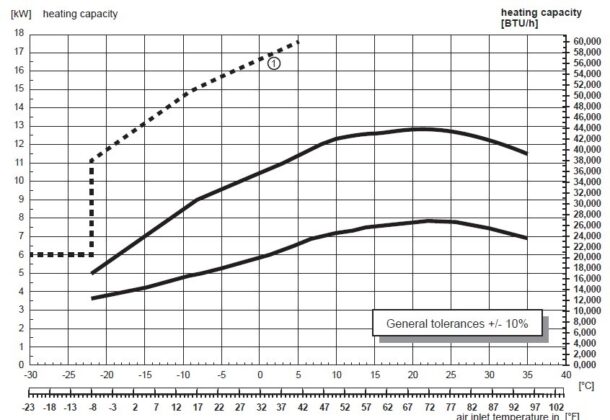
Taco System M, air to water heat pump, heat pumps, heat pump technology, electrification, heating and cooling, plumbing HVAC
John: As you can see from this output chart for the Taco System M, as the outdoor temperature drops, so does the heat pump’s ability to produce BTUs for heating…
Dave: Uhhh, boss . . .
John: It drops off pretty sharply, as you can clearly see from this chart I’m showing you. When you hit 0o F, the output of the heat pump unit itself is about 21,000 BTUH . . .
Dave: Boss . . .
John: And when it hits its low limit of -7o F, its output is only around 17,000. It’s right there, plain as day.
Dave: Boss . . .
John: WHAT?!
Dave: It’s radio, they can’t see the chart.
John: Oh, right. Sorry. Anyway, that’s the case with any air-source heat pump. That’s why System M also includes a 6kW immersion heater in the buffer tank in its companion indoor unit, the HydroBox. That heater adds another 20,478 worth of potential output to the unit, for a total of just under 38,000 at -7o F.
And don’t fret about the immersion heater coming on willy-nilly. It’s intelligently controlled.
Dave: Willy-nilly?
John: It’s an industry term. Who’s our next caller?
Dave: We have Kyle on the line from the alliterative metropolis of Saskatoon, Saskatchewan.
Caller: Greetings, eh? It can get pretty frosty up here in Saskatoon. Can we hook up some backup heat for when it hits 40 below?
John: Gotta tell ya, my favorite Guess Who song ever is “Runnin’ Back to Saskatoon.” I love how it mentions all those great Saskatchewan towns, like Red Deer, Hanna and Medicine Hat.
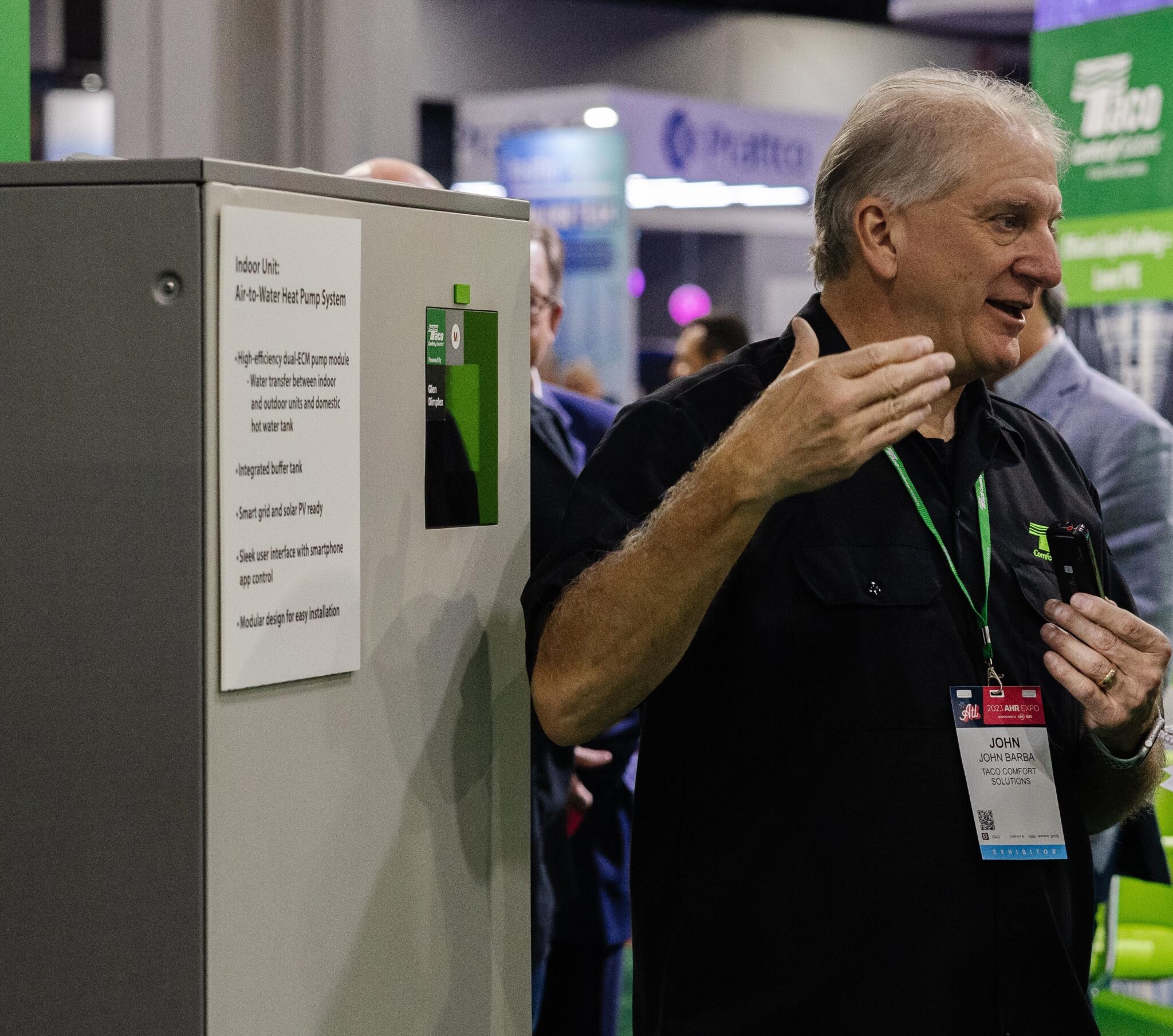
John Barba
Caller: Uh, those towns’re in Alberta. Maybe I could talk to Dave instead?
Dave: I got ya, Kyle. It’s very easy to incorporate a backup or auxiliary heat source with an air-to-water heat pump. If the heat produced by the 37,000-plus BTUH System M at -7o F isn’t enough to heat the home, you can have the auxiliary heat come on at -8. Or, let’s say the heat pump/immersion heater combo comfortably heats a home at 10oF above with a total output of 46,000 BTUH, but it can’t take care of the load once it gets colder than 10oF. Then you can set up an auxiliary heat source – like a gas-fired mod-con – or, if the area isn’t allowing any new fossil fuel burning equipment, an electric boiler could meet that need. It’s actually a simple, single pole-double throw switch activated by outdoor temperature. It turns the heat pump off and turns the boiler on.
John: Great answer Dave. That’s exactly what I was going to say.
Dave: Yeah, but you were still runnin’ back to Saskatoon like the McKenzie Brothers. Let’s go to our next caller, Eric in Minnesota. Go ahead Eric:
Caller: (silence)
John: Eric, what’s your question?
Caller: (silence)
Dave: Welp, Eric’s not here. Let’s move on to Pete from Colorado. What’s up, Pete?
Caller: Hi guys. Long time listener, first time caller. Simple question: how does an air-to-water heat pump switch from heating to cooling?
John: Excellent question Pete. There are lots of ways to do it, ranging from a manual switch combined with turning a bunch of valves on and off, to a simpler, control-based solution.
Dave: That’s right, Boss. An integrated control, like the one with the Taco’s System M, uses an outdoor sensor. Based on the type of home, the climate and the level of insulation in the house, you can program an outdoor temperature at which the system goes into heating mode. Let’s say it’s 53 degrees. You can also program in the temperature at which the system goes into cooling mode. Let’s say that’s 63 degrees.
John: Remember gang, these are just examples. But Dave, if you go into heating mode at 53 oF and cooling mode at 63 oF, wouldn’t that leave a sizable dead band between the two?
Dave: Right you are, Sunshine. In that dead band, System M doesn’t do anything except maybe make domestic hot water if you need it to. If you need cooling and it’s 62 or 63 degrees, you can cool with the reserve of chilled water in the buffer tank. By the same token, if you need heating when it’s 54 or 55 degrees, you’ll have heated water in the buffer tank.
And if you have a houseful of people over for a spring holiday and you’re in the dead band, you can go into a forced cooling mode if you want to.
John: Awesomeness! We have two callers on the line now Dave, and both have the same question. Drake from Idaho and Tom from New Hampshire both want to know how an air-to-water heat pump can make domestic hot water when the heat pump itself is in cooling mode.
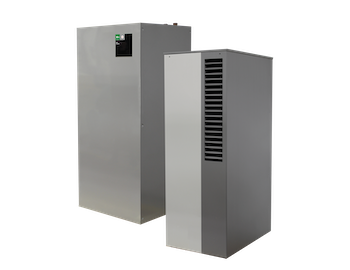 Caller: Yeah, this is Drake. I’m with that Tom guy. It doesn’t make sense that an air-to-water heat pump can make heated water for the indirect hot water tank and chilled water for cooling at the same time.
Caller: Yeah, this is Drake. I’m with that Tom guy. It doesn’t make sense that an air-to-water heat pump can make heated water for the indirect hot water tank and chilled water for cooling at the same time.
Dave: Great observations guys, and you’re correct. An air-to-water heat pump can’t make heated and chilled water at the same time.
Caller: Yeah, this is Tom. That Drake fellah is wicked smaht to ask that question. How can you make the watah hawtt when the freakin’ heat pump is making cold?
Dave: That’s where a buffer tank becomes really important. Let’s say the heat pump is in cooling made. With System M you’ll have a 30 gallon buffer tank filled with chilled water. When the indirect domestic water heater calls to make more hot water, the heat pump immediately jumps into heating mode.
Since you want to make hot water as quickly as you can, you can’t really wait for the 30 gallons of chilled water to be used up. And we don’t want the heat pump to turn all that chilled water into hot water. It would take forever and it’s not exactly what you’d call “green.”
John: Right you are, Dave. That’s where the piping in the System M indoor unit – what we lovingly refer to as the “HydroBox” – comes in. The piping arrangement in the HydroBox is called – are you ready? – a dual differential pressureless manifold. Its job is to hydraulically separate the heating and cooling piping circuits from the buffer tank-heat pump piping circuits. In addition, it also isolates the indirect DHW tank piping from both the heating and cooling circuits.
Dave: Exactamundo, my man. So when the indirect calls to make DHW, the heat pump itself goes right into heating mode, and the hot water from the heat pump bypasses the buffer tank altogether and goes direct to the indirect. The cooling circuit, meanwhile, can still run using the 30 gallons of chilled water that’s still in the buffer tank.
Caller: But won’t that water heat up quickly?
John: It’ll heat up over time, which means two things. First, the best applications for air-to-water heat pumps are very well insulated homes (think steroidal insulation) that don’t heat up or cool down quickly. That buys you time.
Dave: Additionally, you can program the unit to regenerate the hot water tank at specific times. Maybe the best time to do it during cooling season is at night when you’re asleep. You’ll be less likely to notice any temperature creep.
John: Wow, will you look at that. The old clock on the wall says time is up for this week’s edition of Everything You Always Wanted to Know About Heat Pumps* (*But Were Afraid to Ask). Thanks for being with us.
Dave: And if you enjoyed this show, make sure to join John and myself online during the spring and summer on Taco After Dark, our weekly nighttime program dedicated to all things hydronic, plumbing and heat pumps.
The fun starts once the sun goes down!
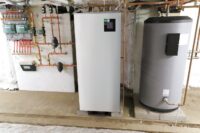
Taco’s System M air-to-water heat pump is meeting the demand for higher efficiencies and the inevitability of beneficial electrification. Coming off the heels of its 2023 AHR Expo Innovation Award for Sustainable Solutions, Taco’s System M’s air-to-water heat pump system is making waves in the field as well. “You really want to come out with Read more
Taco’s System M air-to-water heat pump is meeting the demand for higher efficiencies and the inevitability of beneficial electrification.
Coming off the heels of its 2023 AHR Expo Innovation Award for Sustainable Solutions, Taco’s System M’s air-to-water heat pump system is making waves in the field as well. “You really want to come out with innovative products that provide enhanced value in the marketplace. The System M is just that—the award is a great validation for the entire Taco R&D team,” says Mark Chaffee, Vice President, Product Management, Taco.
Why did Taco, a leading manufacturer of high efficiency indoor heating, cooling, and plumbing comfort systems, dive into the heat pump market? “We saw the trends in electrification coming so we wanted to include hydronically-based heat pumps to our line of already reliable comfort systems products. The last thing we need is more distributed refrigerant systems, if we are going fossil-fuel free and non-CO2 producing equipment, why not do it with water—with a GWP of zero,” says Chaffee.

The System M outdoor unit
System M responds to increasing HVAC electrification trends while providing superior comfort, high efficiency and ease of installation. With just six pipe connections, the heat pump provides up to 44,000 BTUh, 3½ tons of cooling, and a max COP of more than four.
The technology is solar PV and smart grid ready, designed specifically for a low carbon society and built with the knowledge that water is the most efficient and natural energy transfer medium on the planet.
Rural Application
In a single-family, older brick farmhouse in Plainfield, a small town located in north central Vermont, the System M was piloted and installed in February 2020. Thanks to the ingenuity of Rick and Peter Lloyd of Lloyd Home Services, Emerson-Swan and Taco, another satisfied customer was converted to a non-fossil fuel powered heating and colling system with full PV integration.
But, because of Vermont’s extreme cold winter temperatures, the installation did not come without its challenges. “Here in Vermont, there are old homes with little to no insulation in many parts, such as this application before renovations. Though air sealing and spray foam upgrades were added to the home, the seasonal winter temps do offer challenges to heat pump systems holding comfort levels without a back-up or supplemental heat source,” says Rick Lloyd, service manager.
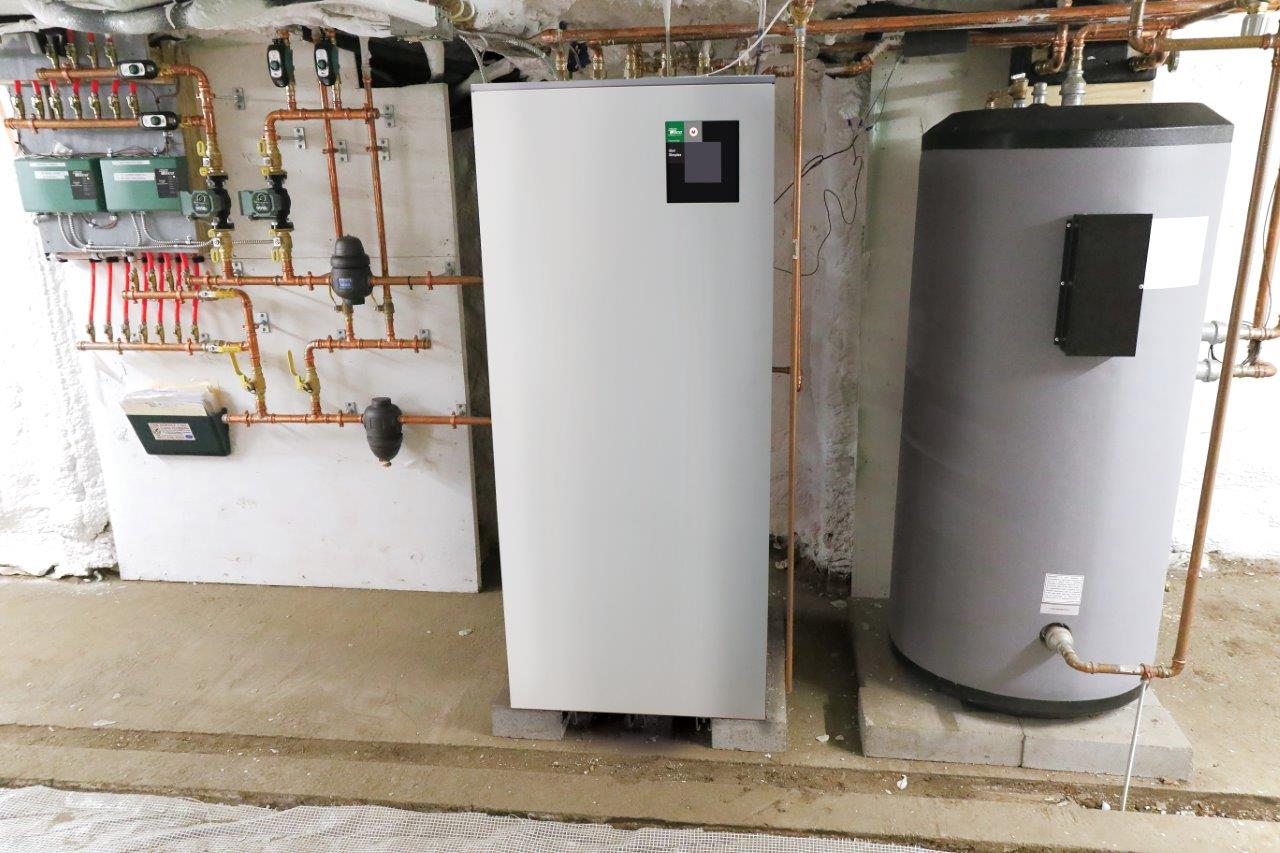
The mechanical room at the Vermont farmhouse
As was the case with Plainfield home, a homeowner’s insulation mistakes, and outdoor temperatures dipping to -20F for consecutive days, concern for supplemental heat was valid, and a back-up pellet boiler was part of the design. When the temperature outside dropped, the back-up pellet boiler kicked-in to provide a secondary natural source of heating. Balancing the two heat generation systems provided the ultimate efficiency throughout the year for a first of its kind fossil-fuel free instalation in Vermont.
There were some early assumptions on BTU heat loss for the historic building that turned out to not be true, says Lloyd. “The proper BTU heat loss survey and calculation in any high efficiency equipment upgrade is important, especially one where the hot and cold extremes are as wide as here in Vermont. As a company we strive to ensure any work—whether a system upgrade or a repair we do in association with heating or cooling—meets or exceeds the desired results,” says Lloyd.
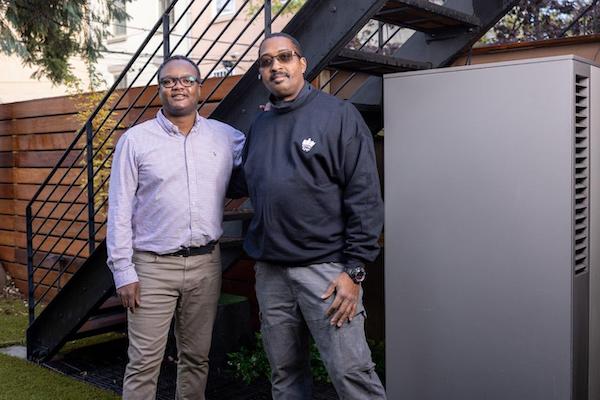
Chester Birchwood (r), owner, HVAC KINGS LLC, stands with the homeowner next to the exterior System M unit.
Because this particular example featured extreme frigid temperatures and excessive summer heat inside the brick house, coupled with inconsistant insulation, the team didn’t realize how much harder we had to work on this particular project, recalls Lloyd. However, “the System M package is well engineered and designed and made to attach easily to system piping, and because this was a 2020 pilot program, this particular system was closely monitored by Taco, and they were able to do most adjustments to the system remotely through the app, as needed to dial in the optimal performance,” says Lloyd.
“I will tell you this, if we’re talking a newly-built or well-insulated, slab home, the System M is definitely the cat’s meow,” says Lloyd. And, says Lloyd, the homeowner is extremely satisfied with the cooling of the home in the summer months using a hydronic-based system.
Big Apple Installation
To the south, a homeowner in Brooklyn, N.Y.—who was an early adopter of sustainable practices—purchased an old home in 2019 and quickly began demo work to gut the home prior to what would become a thorough renovation—removing layers of linoleum and vinyl flooring, and essentially all plumbing and wiring. As the work progressed, they began to specify high-performance windows and ample blown-in cellulose insulation. The home included mostly radiant floors and some in-floor convectors for supplemental perimeter “hydro-air” heat.
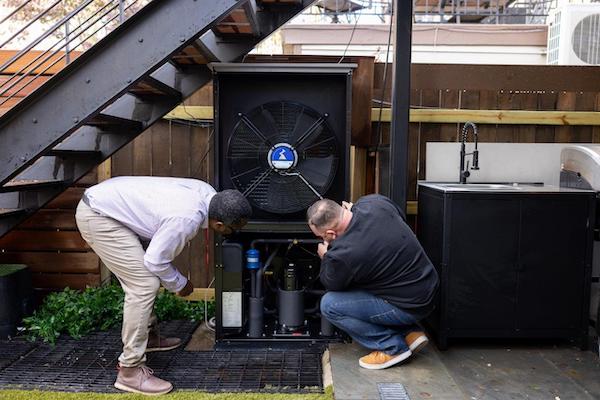
The homeowner called many New York City-area HVAC companies; however they were reluctant to move beyond their comfort work zone, and none were quick to accept the request to install an air-to-water heat pump system, like the System M. Eventually, calls and referrals led to Chester Birchwood, owner, HVAC KINGS LLC, who ultimately became the installation engineer.
Birchwood, in addition to installing a 3.9 Kw solar PV array atop the home, also installed the System M for cooling, heating and domestic hot water. “I’ve become a big fan of the System M, and its viability for residential installations nationwide,” says Birchwood.
The Efficient Choice
The System M technology is solar PV and smart grid ready, designed specifically for a low carbon society and built with the knowledge that water is the most efficient and natural energy transfer medium on the planet. “Water has a global warming potential of zero. The System M offers resiliency, higher efficiencies and lower long-term operating costs,” says Chaffee.
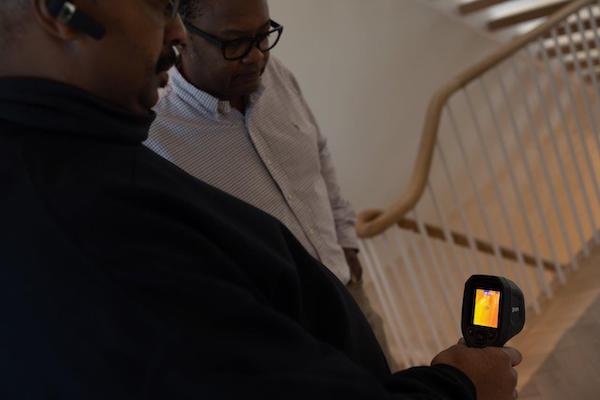
Chester Birchwood use an infrared camera to examine operation of the radiant floor system.
The outdoor portion of the heat pump (monobloc) features advanced inverter technology, a variable speed fan and quiet operation. The indoor HydroBox unit contains an integrated buffer tank, simplified wiring hub, user interface with smartphone app control, and a high-efficiency, dual-ECM pump piping module. The modular design provides turnkey functionality and reduces installation time. “This cuts installation time in half, and gives contractors more confidence that they can do it,” says Chaffee.
